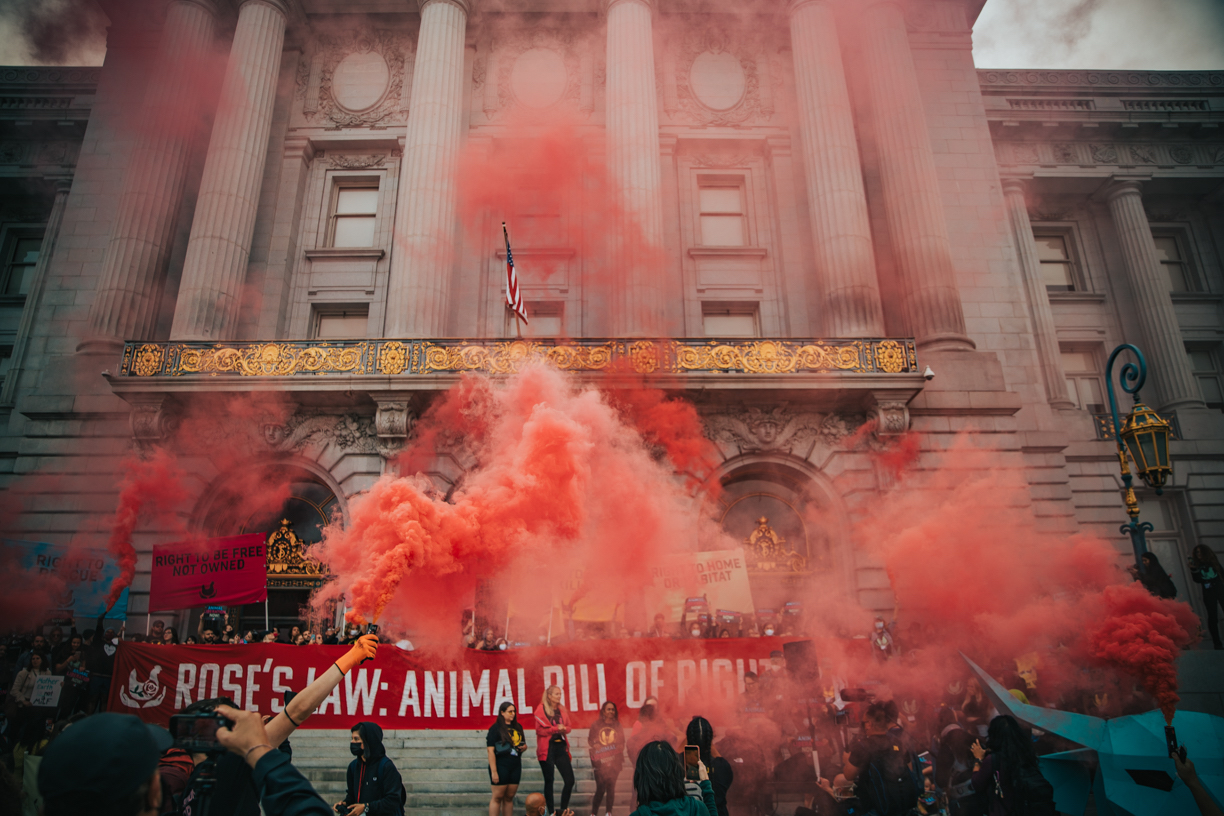The Power of Provocation
By Brian Burns
A Life Disrupted
When I first walked in, I felt very…disrupted. Shook to the very core of my person. Things that I took for granted – the ability to breathe, the right to one’s limbs – were not given here.
I saw the bloody wing torn off of a hen who was ripped from her cage. The stench of months of compacted and rotting feces filled my nose and mixed with my blood. Worst of all, my eyes met with the despondent eyes of Sephy, standing over the body of her dead sister. She was weak, starving, and had given up hope. Sephy had lived her life in a state of constant disruption--not just for a few minutes. Never given a moment of security or safety, her friends or family - or her own existence - could be taken away in an instant.

So when asked, “Why provoke? Why disrupt?” I think back to the words of one of the wisest activists who ever lived, Dr. Martin Luther King Jr.: “e who engage in nonviolent direct action are not the creators of tension. We merely bring to the surface the hidden tension that is already alive.” With this investigation and series of international protests, we are doing nothing more than bringing the truth to the public. It is our duty to do so – the moral obligation we have, given our relative safety as humans.
A Terrified Math Geek

Despite my conviction, I didn’t always feel this way. In fact, for the majority of my childhood, I was a terrified math geek. Mockery from popular or strong kids, when I struggled to catch a football or stammered while constructing a sentence, was the only confrontation I knew – and I hated it. I took solace in the world of mathematics: one not governed by emotion, chance, or social standing. Perhaps my closest friend in high school was a series of textbooks on calculus and geometry that I read on my own time.
This experience also turned out to be my entryway into animal rights. While I had a relatively privileged upbringing, and never had animals in the home, I knew what it was like to be alone. When I first saw a baby calf being torn from his mother, I was consumed with an anger I had never felt before. I stammered as my eyes filled with tears: “Why - Why him? What did he do to deserve this?!” I learned, sadly, that these incidents are not isolated, but are widespread results of our systematic exploitation of other animals.
So I decided to do something, and looked to the most famous organizations and biggest figures in the animal rights scene; but the same fear that had plagued me was also plaguing the movement. We’re simply afraid of saying what we mean. The reality is too harsh, and our families and friends too close, to bring the truth to the public. So I took the mainstream advice of promoting Meatless Mondays, and when my friends were not so inclined, would encourage them to buy from the very same humane facilities that DxE exposed.
Unfortunately, and perhaps predictably, I was met with the same ridicule that brought me to the movement itself. I became the pandering vegan who everyone prodded with bacon jokes. Yet again, my experience mirrored that of the movement as a whole: the animal rights movement is an orphan of the left, subject to ridicule by even the most famous progressives. To date, the movement is known by the public as a strange fringe issue – more of a consumer fad than a social justice movement; more of a personal choice than a moral problem.
Throughout this entire process, I never questioned the anti-confrontation approach. I never dared to touch the unexamined question: What if we could change all of this by simply saying what we mean? What if, instead of honesty being our biggest obstacle, honesty was our strongest weapon?
The Power of Provocation
When I saw a DxE-orchestrated protest for the first time, it made me very angry. These people are making vegans look bad! I wished that these people would put down their signs, quit the chanting, and return to polite, quiet advocacy. It turns out that this sentiment is widespread: Americans don’t like protests. A meta-study by Columbia social scientist Robert Shapiro found that 70% of Americans thought the level of dissent in American society was “dangerous,” and that 74% unconditionally “disapproved” of sit-ins and other public demonstrations.

Why, then, is this evidence in support of provocative tactics? Because the data was recorded in the ‘60s and ‘70s, during the civil rights and anti-war movements in the US. Dr. Martin Luther King Jr., an almost universally revered American hero in the twenty-first century, was almost universally reviled in the twentieth; yet in just a few years, as a result of massive nonviolent protest campaigns, people became much more sympathetic to the very causes they decried. The point: provocative protests challenge the status quo, and change the hearts and minds of people – even if they hate the protesters. Dr. Shapiro writes as summarizing his study, “Americans don’t like protests. But protests may work anyway.”
This phenomenon is one of many ways in which provocation works. Sydney Tarrow, a distinguished social scientist at Cornell, has identified three main mechanisms through which disruption and public protest create social change, in ways that non-provocative forms of advocacy do not:
1. Disruption obstructs routine, and forces attention to the issue. Living in a speciesist society, the exploitation of animals is always present and too often unquestioned. Extreme violence – such as mass shooting and mutilation followed by the ripping up and eating of corpses – is completely normal when done in appropriate places (slaughterhouses, restaurants, and grocery stores). We must change this. We must create a world in which murdering anyone is wrong. Nonviolent direct action disrupts this violent routine and forces people to reconsider what is normal.
Many people, including animal rights activists, become angry when these places are protested, because DxE is doing the absurd: protesting what most accept as okay. But is precisely the normalcy of murdering feeling beings and eating their bodies that demands us to protest - the source of this objection is the very social norm that we have to destabilize. And In order to create a world in which extreme violence is not normal, we must disrupt the places where it is.
2. Disruption provides evidence of determination. The animal rights movement, especially with its consumer-centric framing of veganism, is often perceived as a diet fad. By disrupting routine and condemning the deep convictions of close family and friends, we demonstrate that animal rights is a serious issue for which we are willing to take significant social risk. This evidence of determination in turn flags animal rights as an issue to which the public should pay attention.
3. Disruption broadens the circle of debate to outside the affected and activist community. We live in the world of the 140-character tweet. People are overloaded with information, in addition to their commitments to their work and routine. Often, the only people who care about animal rights issues are animal rights activists themselves. Disruption calls attention to an issue that otherwise would be lost or ignored in today’s sea of information.
Note that none of these mechanisms can be triggered without social cost on our part. In order to disrupt normalcy, we must stand out. While a non-confrontational approach certainly has its merits, and often works well once the issue is a subject of discussion, provocative demonstrations are necessary to bring the issue to the table in the first place.
We must go further. We must provoke our close friends and disrupt places we have accepted as normal from birth. We must accept ridicule, abandonment, and shame for standing out and challenging normalcy. While this is profoundly difficult – as I can attest, as a shy and trembling math geek – we may take some reassurance in the fact that history, social science, and most importantly, morality are on our side.
Other articles

Tulare County Dairy Farms Are Poisoning Latino Communities

The Case for Systemic Change




